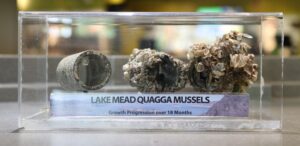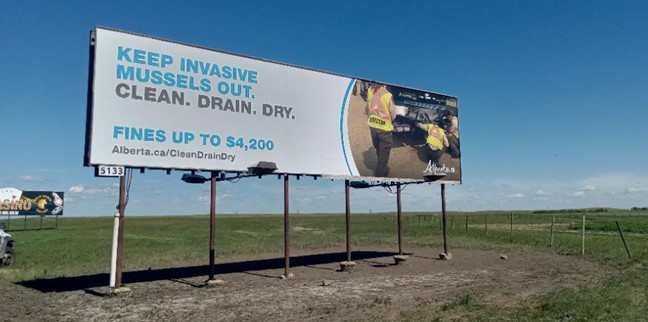To help curb the spread of invasive mussels, boaters are asked to follow the “Clean, Drain and Dry method,” says the Alberta government.
The province is increasing public awareness to help stop zebra, quagga mussels, and other invasive species, from entering Wild Rose country.
Officials say currently, Alberta is zebra and quagga mussel-free, while reports of invasive species are increasing across Canada and the United States.
Tiny mussels can easily spread by latching onto boats and other watercraft, and the government says they can rapidly harm waterways, and infrastructure, destroy habitats, and cause hundreds of millions of dollars in damage.
Billboards are on display near many inspection stations for boaters to highlight increased fines for failing to stop at inspection stations. The awareness initiative will also include graphics inspired by the successful Rat Control campaign and will be displayed on posters to be distributed across Alberta, on social media, and at inspection stations.
The province says this summer, Alberta set the largest fines in North America. Fines for failing to stop with a trailered boat at an open inspection station are now $4,200. Penalties for failing to remove a bilge plug when transporting a watercraft on a roadway are $600.
As of July 24, Alberta has inspected over 5,500 boats and other watercraft. Nine of those were confirmed positive for invasive mussels. Officials say the boats were all entering Alberta from other provinces in Canada or the United States, including a sailboat travelling from Ontario, a ski boat coming from Manitoba, and a boat from Arizona.
The ‘Clean, Drain and Dry’ principle requires boaters to:
Clean:
- Inspect and clean all watercraft, trailers, and gear after every journey
- Remove all mud, sand, water, and plant traces before leaving the shoreline
- Rinse, scrub or pressure wash your watercraft on dry land away from stormwater drains, ditches, or waterways
- Do not use a local carwash – officials say if invasive species are present, you could unknowingly introduce them as the water from the carwash is released into the environment
Drain:
- On land, before leaving the water body, drain all water from internal compartments, bait buckets, coolers, life jackets, and other gear
- Raise and lower outboard engines several times to ensure all water has been drained out
- Drain non-motorized watercraft by inverting or tilting the watercraft, opening compartments, and removing seats if necessary
Dry:
- Dry the watercraft and gear completely between trips and allow the wet areas of your boat to air dry
- Leave compartments open and sponge out standing water

Invasive mussels can damage boats, ecosystems and infrastructure. [Photo: Government of Alberta, supplied]
Going into the Heritage Day long weekend, Minister of Environment and Protected Areas Rebecca Schulz is asking all boaters to do their part to help.
“It’s up to all of us to remain diligent and do our part so these invasive species stay outside our borders,” she states.
“They may be tiny, but the environmental and financial damage they would cause if introduced is massive, so let’s keep invasive species out.”
Earlier this year, the provincial government launched the Aquatic Invasive Species Task Force, increased the number of inspection stations, added more inspectors, and is keeping stations open as long as possible.
Written by: Justin Goulet – Vista Radio



